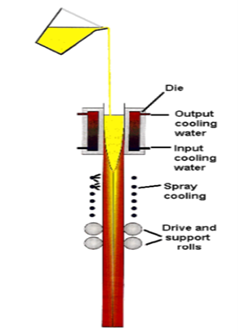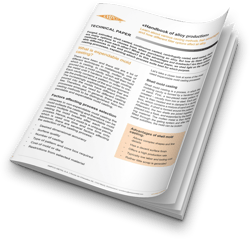Continuous casting is a cost-efficient metallurgic process that allows the production of metal sections with great quality. Besides steel, mainly aluminum and copper are cast with this process which offers various advantages. Let's take a closer look.
In metallurgy, the casting of metals is – along with forging – a widely used method for the production of alloys. In casting, the metal is strongly heated in a furnace until it melts. The molten metal is then filled into prefabricated molds: either into so-called expendable molds, which only last for one casting process or into non-expendable molds, which can be used several times.
There are multiple different methods in order to produce an alloy. Depending on the desired properties of the end product, a manufacturer has to choose between centrifugal casting, sand casting, and many other casting processes. In this blog post, we will have a closer look at continuous casting.
What is continuous casting?
In relation to other casting methods continuous casting is a rather new casting process. In the middle of the 19th century first attempts have been done with the process but it wasn’t until the 1950s until continuous casting received greater reception. It is since known as a very effective method in order to produce semi-finished products. Particularly bars, tubes, stripes, slabs und profiles of copper are manufactured through this process.
Continuous casting: step by step
- Preparations: It is important to choose mold materials with excellent thermal conductivity and oxidation resistance. Therefore, water-cooled crystallization molds, such as high-quality graphite, are used in continuous casting production. The graphite mold is then machined into the required size and shape.
- Melting process: The metal is liquefied in a furnace. The temperatures vary depending on the metal, from around 700° C for aluminum to over 1600° C for steel. The melting point for copper lies in between at around 1100° C.
- Forming process: The molten metal is then poured out of the ladle into an intermediate container, from which it flows through a water-cooled mold and solidifies there in the peripheral zone. The resulting strand, which is still liquid on the inside, is continuously drawn downwards out of the mold. In an arch-shaped cooling chamber, the strand is deflected and sprayed with water before it is finally straightened and cut to length.
Advantages of continuous casting
The high pressure in the holding furnace, combined with the high cooling rate, gives the casted alloy a particularly fine, compact, homogeneous, and high-pressure-tight structure free of impurities. Furthermore, continuous casting produces semi-finished products with a good appearance that are easy to machine and have precise dimensions as well as high mechanical properties.
Further advantages include:
- High quality due to directional solidification
- High volume productions
- High cost-efficiency
- Good and reliable soundness
Horizontal and vertical continuous casting
Depending on the arrangement of the mold, a distinction is made between horizontal continuous casting and vertical continuous casting. In vertical continuous casting, casting is stopped as soon as the mold is full. This process is repeated until there is no more melt. It is typically used to cast aluminum and a few other metals for special applications.

In horizontal continuous casting, the melt runs continuously through the casting system and is cut in advance into the required size. Only when there is no more melt is the casting stopped. The horizontal process is used for non-ferrous metals as well as steel.
What is crucial for a high quality of alloyed products?
Continuous casting is just one of many different possibilities to produce alloys. In order to consistently achieve high quality in alloy production, it is first crucial to carefully consider which casting process is the right one for the required end product. Furthermore continuous process and quality control are the guarantees for obtaining good alloys.
If you want to know more about alloy production in general and its different casting processes, download now our free Technical Paper «Handbook of alloy production»





